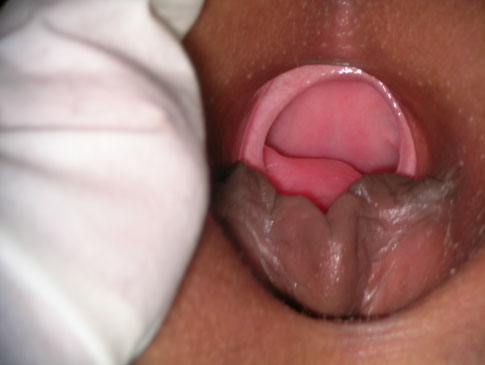A 9-year-old girl is brought for examination due to a concern by her primary care provider regarding her examination findings. The girl lives with her mother and mother’s boyfriend and two younger half-siblings. She does well in school and has no genital complaints or behavioral problems.

Accessible Version
A photo of the hymen of a pre-pubertal female in the knee-chest position. The hymen is thin edged and is a smooth crescentic shape with the anterior edge not visible behind the overlying clitoral hood. Vaginal walls are visible through the opening of the hymen.
Which of the following is a true statement regarding the examination of this crescent-shaped hymen?
◯
A. The hymen edge is less than 1 mm in size at the posterior margin and the finding is suspicious for sexual abuse.
◯
B. The hymen edge may be rolled under and should be further evaluated with another examination technique.
◯
C. The examination reveals a healed transection and is clear evidence of past penetrating trauma.
◯
D. The width of the hymenal opening is larger than normal and is suspicious for sexual abuse.
Which of the following is a true statement regarding the examination of this crescent-shaped hymen?
◯
A. The hymen edge is less than 1 mm in size at the posterior margin and the finding is suspicious for sexual abuse.
✓
B. The hymen edge may be rolled under and should be further evaluated with another examination technique.
◯
C. The examination reveals a healed transection and is clear evidence of past penetrating trauma.
◯
D. The width of the hymenal opening is larger than normal and is suspicious for sexual abuse.
The best answer is B
This is a crescent or annular hymen. The area under the clitoral hood is not well seen and therefore the configuration is difficult to ascertain. Medical examiners frequently are only able to achieve a quick glimpse of the hymenal structures in children due to either patient non-compliance or examiner lack of experience. In this case, the posterior area is also slightly covered by the posterior fourchette. The hymen is most likely crescent shaped in configuration based on the age and tanner stage of the patient. As the child matures, the estrogen effect will likely result in thickening and whitening of the hymenal membrane with evolution through stages until a typical fimbriated hymen is observed.
Attention should be given to the edge of the hymen. If the posterior region is less than 1 mm in depth from the edge of the hymen to the vaginal wall, this may indicate that previous trauma has occurred and healed. See reference below. Further evaluation of the edge, using a moistened swab, saline flushes or balloon catheter may be used to assist with visualization. In some cases, examination in the prone knee-chest position will cause the hymen edge to fall forward due to gravity and enable better visualization.
There is no sign of healed or acute hymenal transection on this photograph. Measurement of the vaginal opening width does not correlate with a history of sexual abuse or vaginal penetration and is not recommended.
- Adams JA. Guidelines for medical care of children evaluated for suspected sexual abuse: An update for 2008. Current Opinion in Obstetrics and Gynecology. 2008; 20 (5) : 435-441.The recommendations for the timing and type of examinations for prepubertal children, in contrast to adolescent sexual assault victims, may need to be changed. Studies showing that partial tears of the hymen, as well as abrasions and contusions, may heal to leave very little or no sign of previous injury emphasize the importance of urgent evaluations. There is a need for standardization of the training of medical professionals who perform child sexual abuse evaluations to ensure continuing competence. \textcopyright 2008 Wolters Kluwer Health | Lippincott Williams & Wilkins.
- Starling SP, Jenny C. Forensic examination of adolescent female genitalia: the Foley catheter technique. Archives of Pediatrics & Adolescent Medicine. 1997; 151 (1) : 102-3.Inspection of female adolescent genitalia for the evaluation of suspected sexual abuse is often a difficult task for the examiner. The hymens of Tanner III through Tanner V adolescents are normally estrogenized and, therefore, often thickened and redundant on examination. Examination of the margins of the hymen is difficult by visual inspection alone. Many authors1-5 recommend the use of a cotton-tipped swab to explore the hymenal margin. Even this technique can offer little advantage if the hymen is excessively redundant. One purpose of the sexual abuse examination is to examine the margins of the hymen for disruptions. These are especially concerning if the clefts extend to the hymental base, defined as the junction of the hymen and the vestibule.6 In the case of redundant tissue, it can be impossible to fully explore the entire hymen with use of a swab, because the tissue often folds back on itself



